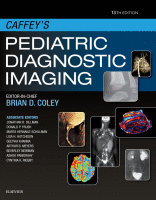Physical Address
304 North Cardinal St.
Dorchester Center, MA 02124

Overview When the first edition of this textbook was published in 1945, its title was Caffey's Pediatric X-ray Diagnosis, denoting the single modality available at the time. In the intervening seven decades, there have been twelve additional editions of the…

Abdominal Wall and Peritoneal Cavity During the third week of gestation, the intraembryonic mesoderm differentiates, forming the lateral plates. Mesoderm from paravertebral myotomes invades the lateral plates during the sixth week. The leading edges of the lateral plates will differentiate…

This chapter reviews acquired diseases of the thoracic aorta, venae cavae, pulmonary arteries, and pulmonary veins seen in childhood. Acquired pediatric aortic disease is uncommon, but radiologists and imagers play an important role in the care of these patients. Pulmonary…

Numerous systemic diseases can affect the heart and great vessels and are important causes of cardiac dysfunction. These systemic diseases include both prenatal and postnatal toxic and infectious exposures ( e-Fig. 81.1 ); adverse effects of therapeutic agents; and various…

Primary cardiac tumors are rare in children, with a reported prevalence of up to 0.32%. Use of echocardiography has resulted in more frequent detection of cardiac tumors in the fetus and neonate. More than 90% of pediatric cardiac tumors are…

Myocardial Diseases Cardiomyopathies include various diseases of the myocardium, often chronic or progressive, and associated with cardiac dysfunction. These are rare but serious disorders; only 25% of children survive more than 5 years after the onset of symptoms. Although our…

A large number of syndromes, dysplasias, and chromosomal anomalies are associated with congenital or acquired cardiac and vascular disease. This chapter discusses the cardiovascular features of some of the more commonly encountered lesions. A more extensive list is provided in…

The author would like to acknowledge Frandics Chan, MD, PhD, for his contributions to prior editions of this chapter. Coronary artery disease in children can be acquired, but the majority of anomalies are congenital. Among acquired coronary abnormalities, Kawasaki disease…

This chapter covers congenital anomalies of the great arteries that result in a vascular ring or sling. Overall, anomalies of the aortic arch and the cervical vessels are relatively common, with an estimated prevalence of 0.5% to 3%. They can…

Conotruncal anomalies are a group of congenital heart defects involving the outflow tracts of the heart. The conotruncal anomalies include tetralogy of Fallot (TOF), transposition of the great arteries (TGA), double-outlet ventricles, truncus arteriosus, and interrupted aortic arch (IAA) type…